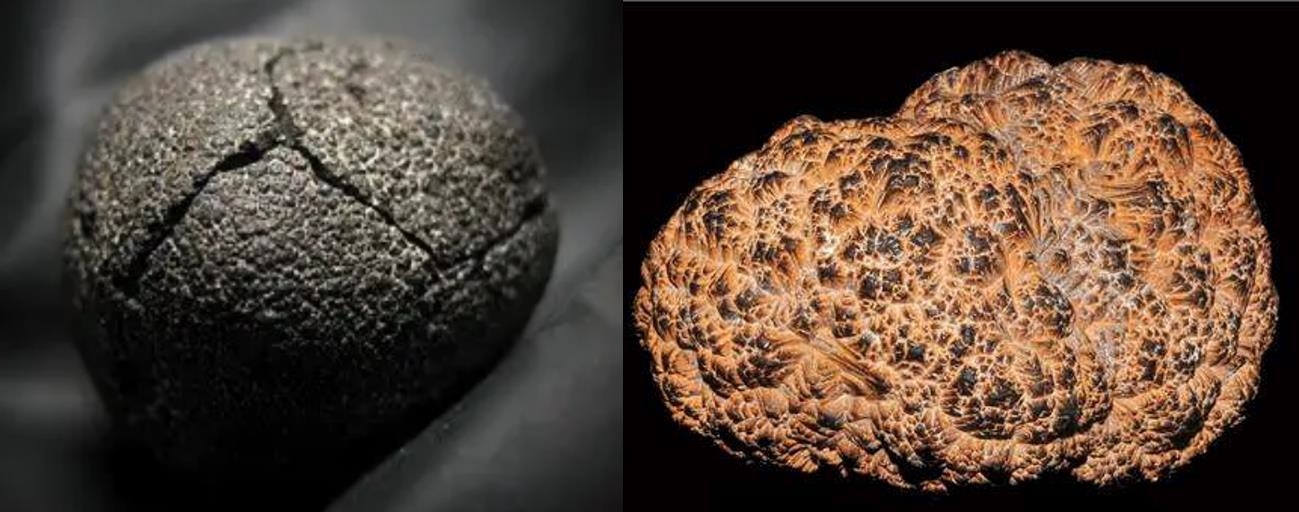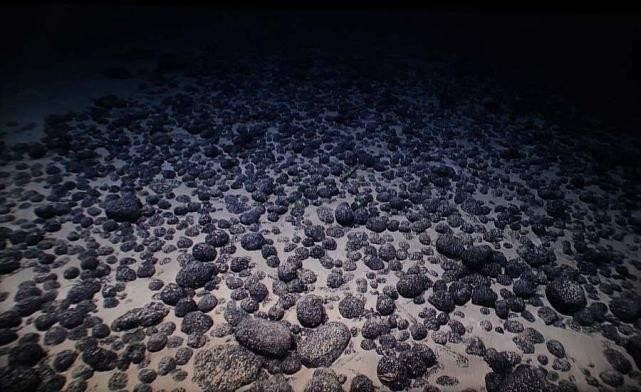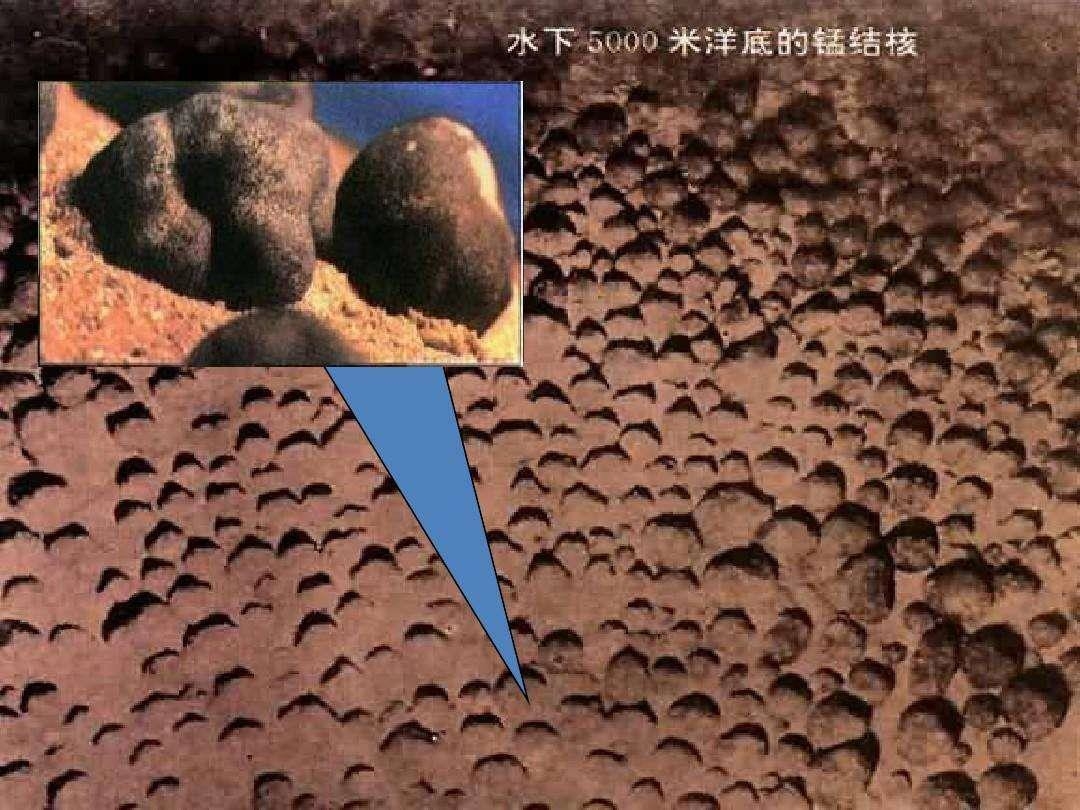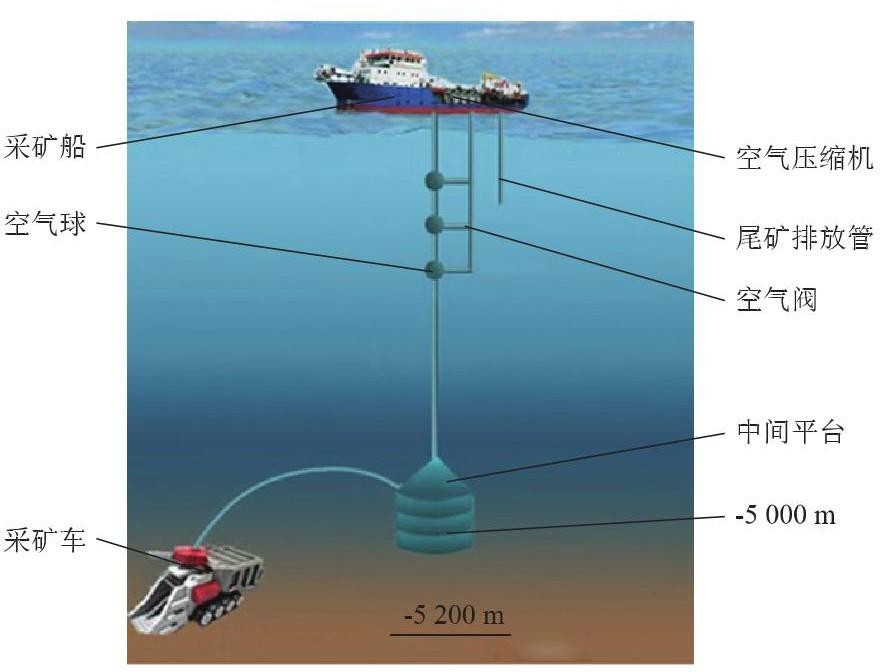随着人类文明的不断进步和科技发展的日新月异,人类对资源的探索已逐渐由陆地转向海洋。1872 年,英国一艘名为“挑战者”号的海洋调查船在加那利群岛作业时,首次在海洋中发现矿块。该矿块呈黑色或棕褐色,形似马铃薯,裹着厚厚的金属颗粒。因颗粒的主要成分是锰和铁,故有人称其为“海洋金属结核”或“海洋锰结核”。
With the continuous progress of human civilization and the rapid development of science and technology, human exploration of resources has gradually shifted from land to sea. In 1872, a British marine survey vessel named “Challenger” was operating in the Canary Islands when it first discovered one kind of ore nodule in the ocean. The nodule was black or brown in color, shaped like a potato and covered with thick metal particles. Since the main components of the particles are manganese and iron, some people call the nodule “marine metal nodule” or “marine manganese nodule”.

海洋锰结核结构组成
Structural composition of marine manganese nodule
海洋锰结核多以贝壳、鱼齿、珊瑚片、岩屑等为核心及围绕它的壳层组成。其存在形式主要为硅酸盐和难溶性高锰酸盐,化学成分比较复杂,除含锰、铁、铜、钴、镍、铅等常见金属外,还含有钛、钼、锆、镭、镧、铊等稀有金属。
Most of the marine manganese nodules are composed of shells, fish teeth, coral fragments and rock chips as well as the shell layer around it. The chemical composition is relatively complex, containing not only common metals such as manganese, iron, copper, cobalt, nickel and lead, but also rare metals such as titanium, molybdenum, zirconium, radium, lanthanum and thallium.
海洋锰结核的物质组成取决于熔岩喷发区地幔深处的物质构成。由于不同海区地层中的元素含量不同,故太平洋、印度洋和大西洋中的锰结核化学成分各有区别。此外,海洋锰结核的形状、硬度等因熔岩喷发强弱程度而存在显著差异。能量大,温度高的熔岩喷发形成的锰结核个体大,质地较硬;反之,能量小、温度低的熔岩喷发所形成的锰结核个体小,硬度较低[1]。
The material composition of marine manganese nodules depends on the material composition deep in the mantle of the lava eruption area. The chemical composition of manganese nodules in the Pacific Ocean, Indian Ocean and Atlantic Ocean is different because the elemental content in the strata of different sea areas is different. In addition, the shape and hardness of marine manganese nodules vary significantly depending on the intensity of lava eruptions. The manganese nodules formed by high-energy and high-temperature lava eruptions are large and hard; conversely, the manganese nodules formed by low-energy and low-temperature lava eruptions are small and less hard.

海洋锰结核形成因素
Factors of forming marine manganese nodule
关于海洋锰结核成因问题的研究,科学家主要围绕三个问题进行: 锰结核元素的供给源来自哪里?锰结核的沉积地点是怎样形成的?锰结核的生长机理是什么?
The research on the formation of marine manganese nodules has focused on three questions: Where does the source of supply of manganese nodule elements come from? How are the deposition sites of manganese nodules formed? What is the growth mechanism of manganese nodules?
锰结核元素的供给源主要来自四个方面:a.来自大陆各种金属元素,沉积到海洋之中形成;b.来自海底火山喷发,火山气体和海水相互作用后金属元素进入海水后沉积;c.来自海洋浮游生物,浮游生物死亡后体内的金属元素进入海底沉积;d.来自宇宙空间,每年大约有几千吨宇宙尘埃进入地球,它们富含金属元素,分解后进入海洋。
The supply sources of manganese nodules are as follows: a. They are from various metallic elements in the continents which are deposited into the ocean; b. They are from the volcanic eruptions under the sea where metallic elements are deposited after the interaction between volcanic gases and seawater; c. They are from the marine plankton where metallic elements in the plankton’s body are deposited under the sea after death; d. They are from the cosmic space whose several thousand tons of cosmic which are rich in metallic elements dust enter the earth every year and go into the sea after decomposition.
锰结核的沉积地点形成:金属元素通过各种渠道和搬运方式,来到具备形成锰结核的“核”上,经过漫长的岁月,形成大小不等的锰结核。在研究这些金属元素的搬运方式上,科学家普遍认为是通过海水溶解后来到锰结核的“核”上的[2]。
The formation of manganese nodules deposition sites: The metallic elements come to the “nucleus” with the ability to form manganese nodules through various channels, and after a long period of time, manganese nodules of different sizes are formed. In studying the transport of these metallic elements, scientists generally believe that they come to the “nucleus” of manganese nodules through dissolution of seawater.
锰结核的生长机理一般有三种说法:a.生物成因,锰结核的金属来源于沉降到海底的海洋动物遗骨,当它们被生活在结核表面的底栖微生物食用后,使金属聚集,逐渐使锰结核增长;b.火山成因,锰结核是由海底火山及由此产生的火山岩的缓慢蚀变,使岩石中含有的金属被淋滤,经过沉淀而形成的;c.自生化学沉积,锰结核的金属源自海水和沉积物的孔隙水,河流将大陆上的某些金属元素和沉积物带到海中,经过自生化学沉积作用而形成锰结核[3]。
People think there are three kinds of growth mechanisms of manganese nodules: a. Organism. The metal of manganese nodules comes from the bones of marine animals that sink to the bottom of the sea, and when they are eaten by the benthic microorganisms living on the surface of the nodules, the metals accumulate and gradually make the manganese nodules grow; b. Volcano. The manganese nodules are formed by the slow alteration of the volcanoes on the sea floor and the resulting volcanic rocks, so that the metals contained in the rocks are leached and precipitated; c. Authigenic chemical deposition. The metals of manganese nodules originate from the pore water of seawater and sediments, and rivers bring certain metallic elements and sediments from the continents to the sea which can form the manganese nodules through authigenic chemical deposition.

海洋锰结核分布范围
Distribution range of marine manganese nodule
海洋锰结核主要蕴藏于各大洋 2000~6000 米的深海中,而以生成于 4000~6000 米海底的品质最佳。海洋锰结核的分布区域、数量与地质构造密切相关,海底熔岩喷发频繁的海底山脉、地壳裂缝区域,锰结核覆盖面积大,密集度高。而在极少海底火山的大陆架和内海区域,由于缺乏形成锰结核的地质环境,所以基本上没有锰结核的分布。当然不能排除由于海底地形起伏与洋流冲刷作用造成锰结核从较高的地势向较低的地势移动后,出现在没有海底火山活动的深海区域。
Marine manganese nodules are mainly found in the deep sea from 2,000 to 6,000 meters in all oceans, and the best quality can be found in the 4,000-to 6,000-meter sea floor. The distribution area and quantity of marine manganese nodules are closely related to the geological structure, and the area covered by manganese nodules is large and dense in the submarine mountain range and crustal fracture area where submarine lava eruptions are frequent. In the continental shelf and inland sea areas where there are few submarine volcanoes, there is basically no manganese nodules due to the lack of geological environment for the formation of manganese nodules. Of course, we cannot exclude the case that manganese nodules are found in the deep-sea areas without submarine volcanic activities but with the movement from higher to lower terrain due to the topographic relief of the seafloor and the scouring effect of ocean currents.

海洋锰结核利用价值
Utilization value of marine manganese nodule
据调查,世界各大洋中锰结核总储量约 30000 亿吨,仅太平洋底锰结核储量就有 17000 亿吨,其中含锰 4000 亿吨、铁 3200 亿吨、镍164 亿吨、铜 88 亿吨、钴 58 亿吨。海洋锰结核中的金属储量远高于陆地,它们相当于陆地铜矿储量的 50 倍,锰矿储量的 200 倍,镍矿储量的 600 倍,钴矿储量的 3000 倍。更令人称奇的是,由于海洋生物作用,锰结核还以每年 1000 万吨的速度继续增长着,被人们称为取之不尽,用之不竭的“活矿床”[4]。
According to a survey, the total reserves of manganese nodules in all oceans of the world are about 300 billion tons, and the reserves of manganese nodules in the bottom of Pacific Ocean alone are 1,700 billion tons, including 400 billion tons of manganese, 320 billion tons of iron, 16.4 billion tons of nickel, 8.8 billion tons of copper and 5.8 billion tons of cobalt. The metal reserves in marine manganese nodules are much higher than those on land, and they are equivalent to 50 times the land reserves of copper, 200 times the reserves of manganese, 600 times the reserves of nickel and 3,000 times the reserves of cobalt. What’s more, due to the marine organisms, manganese nodules continue to grow at the rate of 10 million tons per year, which is known as an inexhaustible “living mineral bed”.
海洋锰结核开采手段
Mining methods of marine manganese nodule
海洋锰结核的开采方法主要有以下三种:
1. 水力提升式采矿系统,用集矿装置在海底把锰结核挑选、收集在一起,用高压水泵把它们通过采矿管提升到船里;
2. 空气提升式采矿系统,用高压空气泵通过输气管将压缩空气打到海底,把海底锰结核连同水和气从采矿管压到船里;
3. 连续链斗式采矿系统,用链斗把矿石运上来。
There are three main mining methods for marine manganese nodules as follows.
1. Hydraulic lift mining system: manganese nodules are selected and collected together on the seabed by collecting devices, and lifted into the ship through the mining pipe by high-pressure pumps.
2. Air-lift mining system. The compressed air is pumped to the seafloor by high-pressure air pumps through the air pipeline, and the seafloor manganese nodules, together with water and gas, are pressed from the mining pipe to the ship.
3. Continuous rope mining method. The ore is brought up by a chain bucket.

气举泵提升示意图
Schematic diagram of air-lift mining system
问题与展望
Problems and prospects
目前,开发海洋锰结核面临技术、经济和政治等多方面的风险,是一项耗资巨大、风险极高的工程。相比于陆地几千米深的矿井,在海底挖掘的难度远高于地表外层。神秘莫测的海底环境,对深海作业的装备要求极高,不仅要承受深层海水的压力和腐蚀,还要抵御海洋的复杂洋流。除了深海采矿技术方面的不足,经济投资也是一项棘手问题。矿业投资本就不同于其它投资,开发周期长,投资见效慢,不确定性大。海洋矿业更甚于陆地,导致很少有企业进行经济投入。
At present, the development of marine manganese nodules faces many technical, economic and political risks, and is a very costly and risky project. Compared with a mine shaft thousands of meters deep on land, it is much more difficult to mine on the seafloor than in the outer layers of the earth’s surface. The mysterious and unpredictable environment of the seafloor places great demands on the equipment used in deep-sea operations, which must not only withstand the pressure and corrosion of deep seawater, but also the complex currents of the ocean. In addition to the technical shortcomings of deep-sea mining, economic investment is also a difficult issue. Mining investment is inherently different from other investments, with long development cycles, slow payoffs and high uncertainty. This is even more true for marine mining than for land-based mining, resulting in little economic investment.
尽管海洋锰结核的开发存在多种不确定因素,但其商业性开发只是时间问题。一是因为越来越多的国家正进入工业化发展阶段,对金属的需求量快速增加;二是因为金属矿产资源不可再生,特别是易处理的富矿越来越少。此外,相关海洋矿产开采技术的发展也加快了海洋锰结核的开发进程。
Despite the multiple uncertainties surrounding the development of marine manganese nodules, it is only a matter of time before they are commercially exploited. Firstly, more and more countries are entering the industrial development stage and the demand for metals is increasing rapidly; secondly, metal mineral resources are non-renewable, especially the rich ores that are easy to handle are becoming less and less available; thirdly, the development of related marine mineral mining technology has also accelerated the process of marine manganese nodule development.
参考文献
[1] Hein J R, Staudigel H, et al. Seamount mineral deposits: a source of rare metals for high-technology industries[J]. Oceanography, 2010, 23(1), 184-189.
[2] 周怀阳. 深海海底铁锰结核的秘密[J]. 自然杂志, 2015, 37(6), 397-404.
[3] Baturin G N, Dubinchuk V T, et al. Hydrothermal manganese mineralization in the Peterbourgskoye ore field (North Atlantic)[J]. Oceanology, 2014, 54(2), 222-230.
[4] 牛京考. 大洋多金属结核开发研究述评[J]. 中国锰业, 2002, 20(2),23-29.
References:
[1] Hein J R, Staudigel H, et al. Seamount mineral deposits: a source of rare metals for high-technology industries[J]. Oceanography, 2010, 23(1), 184-189.
[2] Zhou Huaiyang. Metallogenetic mystery of deep-sea ferromanganese nodules[J]. Chinese Journal of Nature, 2015, 37(6), 397-404.
[3] Baturin G N, Dubinchuk V T, et al. Hydrothermal manganese mineralization in the Peterbourgskoye ore field (North Atlantic) [J]. Oceanology, 2014, 54(2), 222-230.
[4] Niu Jingkao. Research and development of oceanic multi-matal nodule[J]. China Manganese Industry, 2002, 20(2),23-29.
 公众号
公众号